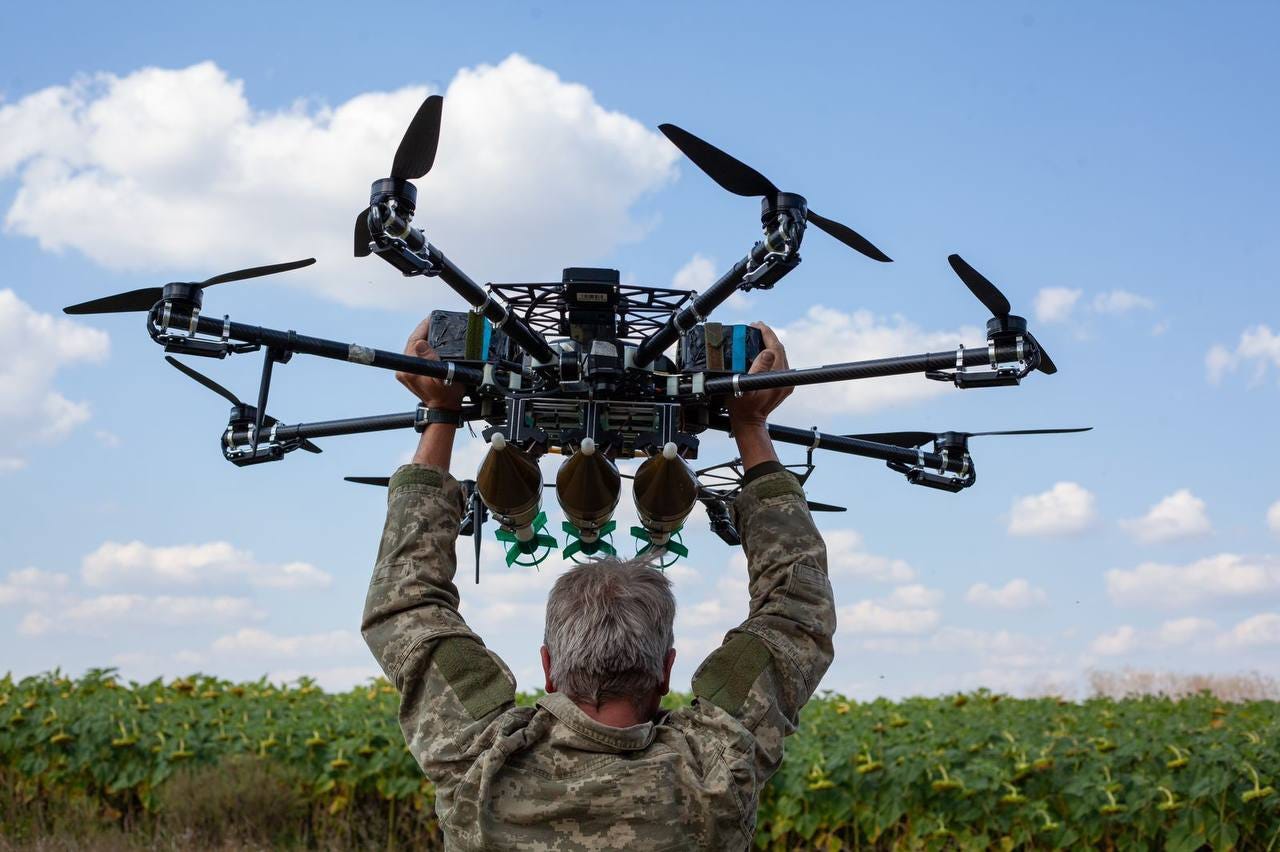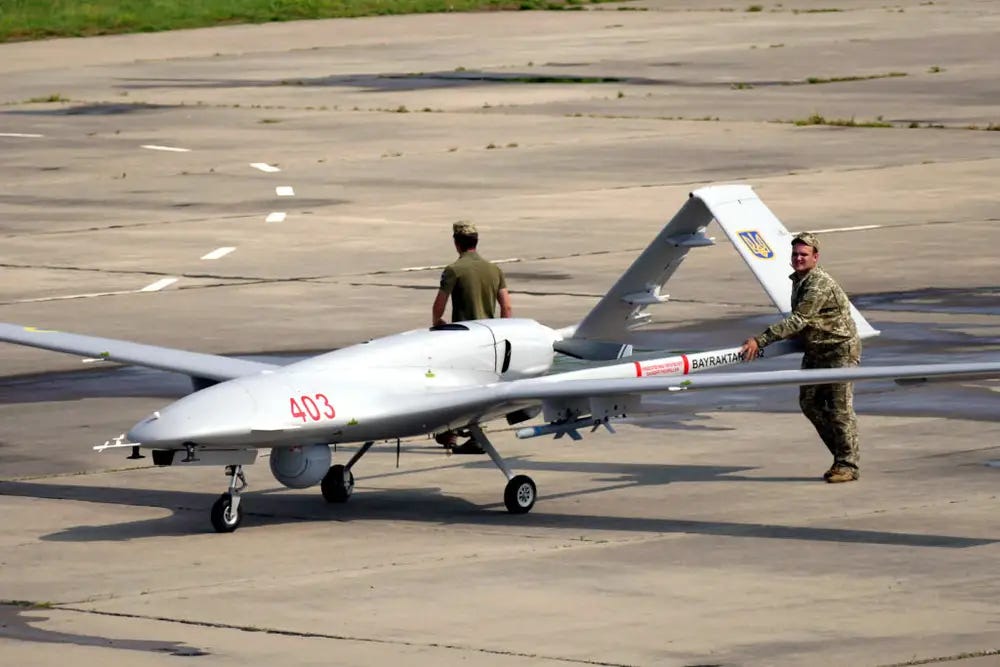
Important changes have a way of happening slowly, then all at once. Nowhere is this more evident than in warfare.
On December 7, 1941, the United States Navy was sitting at anchor in Pearl Harbor when they were attacked by a Japanese force using what was then a relatively new and unproven tactic: a carrier-launched air assault. These destroyed a large number of ships at port, causing a major setback for the United States in the opening stages of their involvement in World War II.
A similar “Pearl Harbor” moment occurred recently in Ukraine “Operation Spider Web.” 117 Ukrainian drones struck targets deep inside Russian territory, destroying a large chunk of Russia’s strategic aviation fleet. Bomb-laden drones were packed into sheds on the backs of 18-wheelers and transported to positions outside Russian airbases. Seven of Russia’s Tupolev Tu-95 strategic bombers — iconic of the Cold War — were destroyed, and another was badly damaged.
And then — just weeks later — we saw a dramatic Israeli operation called Operation Rising Lion, which decapitated much of Iran’s military leadership, aimed at removing their ability to produce nuclear weapons that could threaten Israel.
How was Rising Lion launched? The opening strikes involved 200 manned aircraft from the Israeli Defense Force. But the skies were cleared through the use of secret drone bases, set up throughout Iran, which launched UAVs to take out Iranian air defense sites.
An Abridged History of Drone Warfare

Unmanned aircraft date back farther than you might think. In World War I, unmanned craft were used for target practice - this is actually where the term “drone” originates. But drones didn’t really come into their own until much, much later.
During Operation Desert Storm, the United States and its Coalition allies expected a brutal fight against the massive, reasonably well-equipped Iraqi army. Overwhelming Coalition air and naval power though saw a very different conflict.
Pioneer drones were launched from the US battleships Missouri and Wisconsin and used to adjust naval artillery. 40 pioneers flew a total of 1,641 hours, with at least one always in the air. This led to a famous moment on Feb. 27, 1991, when Iraqi soldiers surrendered to an American Pioneer drone.

These drones were unarmed, but this of course changed quickly. US forces made extensive use of armed drones — especially the iconic MQ-9 Reaper, shown above. These drones were comparatively cheap, and could loiter over target areas for over a day at a time, waiting for the right time to launch a missile strike and kill a particular target.
The Reaper, though, was an extension of already-predominant American air power. Each drone cost about $30 million, which, while significantly less than the $102.1 million pice tag of an F35-C Lighting II, is still quite expensive. In addition, there were major questions about how drones could be useful in “peer” or “near-peer” conflicts between actual nation-states. This changed in 2020, when Azerbaijan and Armenia went to war over a disputed territory called Nagorno-Karabakh.
Armenian forces were dug in and prepared for a fight following the First Nagorno-Karabakh War which lasted from 1988 to 1994. But this new conflict would be fought on a very different trajectory, lasting only forty-four days and ending in a resounding victory for Azerbaijan.

The Azeri military used large numbers of cheap, disposable drones; both Turkish Baykraktar drones and modified Soviet An-2 biplanes. Why biplanes? Because they were extremely cheap to retrofit and could be used as “bait” for Armenian air defense positions. When the positions fired upon the consipcuous, slow-moving An-2 drones, they revealed their locations, exposing them to follow-up attacks.
Thus, Nagorno-Karabahk became the proving ground for drones in large-scale, open, conventional warfare.
“Where there is Mavic, there is death.”

In Ukraine, the utilization of drones has reached a new level, with terrifying new drone weapons designed on a much smaller scale. FPV drones are deployed to hunt enemy troops, leading to a constant arms-race as countermeasures are developed and new ways to circumvent those countermeasures are developed in turn.
Combatants in Ukraine make heavy use of drones both for active combat and for surveillance. As one Russian blogger noted:
Drone war is not the future, it is yesterday.
In addition to armed direct-attack craft like the FPV drones, swarms of small reconnaissance drones like the Mavic are constantly hunting for targets. They do not take time off. They can see movement from kilometers away. They’re used to direct heavier assets like artillery or the “Baba Yaga” bomber drones mentioned above. You might never see the drone that targeted you.
And all of this is unfolding right in front of us. On OSINT Twitter accounts like @OSINTtechnical, you can find video footage of combat operations today, as they are happening. See, for example, this footage of an Israeli Apache gunship shooting down an Iranian Shahed drone.
The same logic applies to the militaries operating in Ukraine: Russian drone operators are performing interceptions and operations live, with their commanders watching — making modern warfare something uncomfortably akin to a deeply stressful video game livestream.
Abundance in All Things
The most striking aspect of drone warfare is that it has lowered the cost of air power down to something that is accessible to smaller nations and even nonstate actors. Drones remain difficult to defend against, and even harder to defend against economically: the Israeli interceptors used to shoot down Iranian Shahed drones and ballistic missiles were substantially more expensive than their targets.
Ukraine, in part, has achieved its successes through focusing on mass-producing cheap, attritable aircraft that can dominate surveillance and combat operations in the lower skies. They make heavy use of drones like the DJI Mavic, a consumer camera drone meant for video recording and surveillance.
But nowhere is this more obvious than Africa. Across the Sahel, militants transform civilian drones into weapons with frightening ease. Drone attacks in Khartoum took out power, plunging much of Sudan into darkness.
In a way, this is a dark mirror of the general promise of robotics: automation promises more of all of the things we want, and unfortunately one of the things many people want is violence.
The promise of robotics and automation becomes greatly destabilizing because of how accessible it has made these sorts of attacks: during the Iraq War, insurgents needed to plant IEDs along patrol routes and lacked ways to seriously threaten allied bases. Now, though, they can improve an armed IED drone and fly it directly to the target with low risk to themselves and a much higher chance of causing damage.
Final Thoughts
Robotic warfare is not some future reality. Right now, drones cause 70% of the casualities in Ukraine. Followups to Operation Spiderweb have struck across many different Russian regions; and, of course, Russia constantly bombards Ukraine with its own drones and missiles.
I write this in part because it’s interesting — warfare has shaped human societies, like it or not, for all of our history, and it’s likely to continue doing so. But also because I think very few of us involved in the development of technology like to wrestle with the many ways it will be used, in the future.
Technological innovation gives us great things. Democratic Ukraine is able to resist invasion in large part because of drones, because its people are innovative and resourceful and have come up with ways to level the playing field. But it’s never a pure, unalloyed good; there will always be dark aspects that we must acknowledge.
And maybe that’s the best takeaway here. Drones seem to be a great leveler: whether you’re a smaller country facing invasion or an insurgent group fighting the government. This is the sort of thing that precipitates great changes in societies, and the greatest of those changes are yet to come.
Further Reading
The Future of Warfare is Remote Controlled by Francis Fukuyama
Delegation and Destruction by Francis Fukuyama





Nicely written!